User Manual
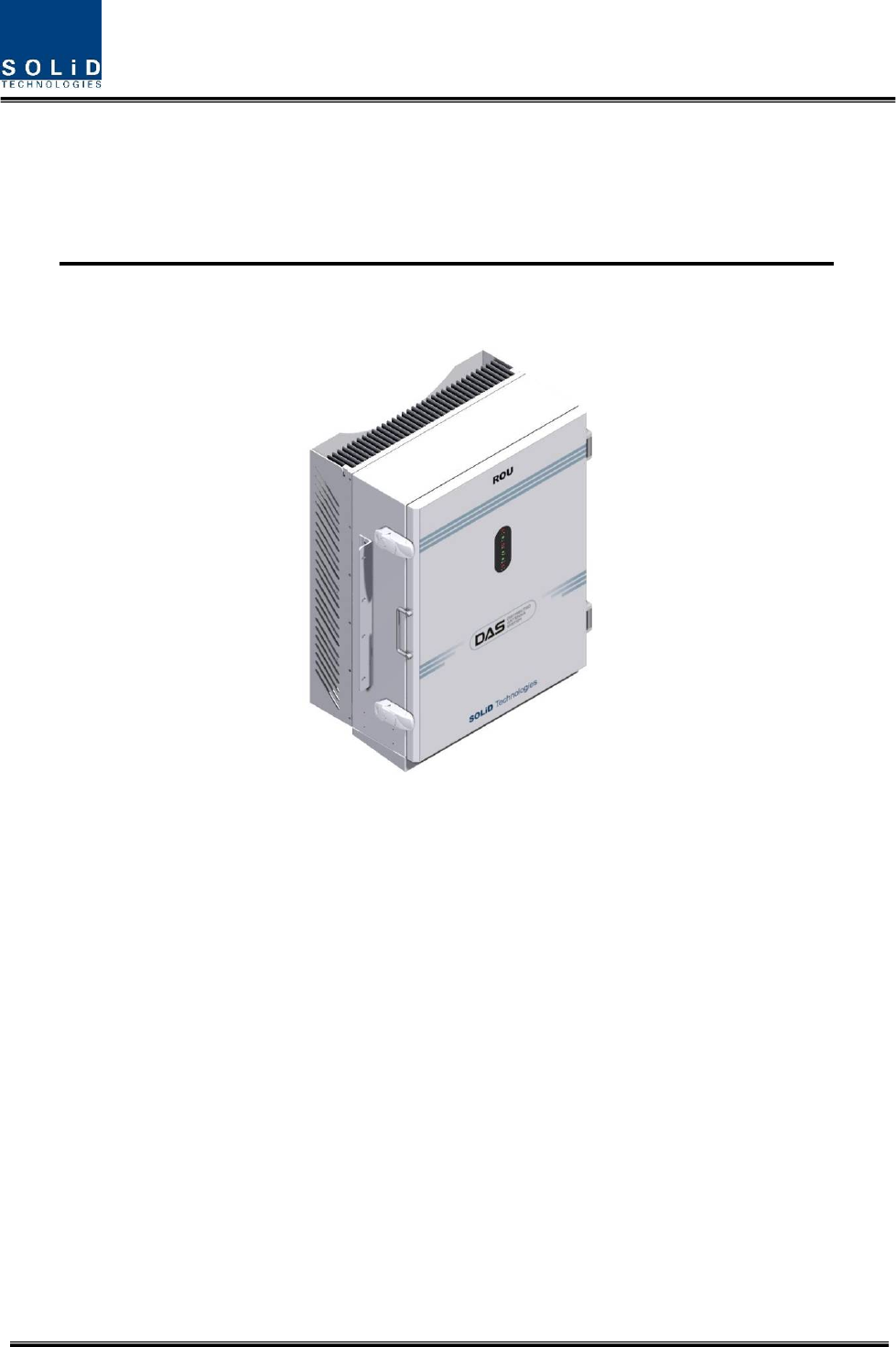
Confidential & Proprietary 1/27
SMDR-NH124(Remote Unit)
UserManual

Confidential & Proprietary 2/27
REVISION HISTORY
Version Issue Date No. of
Pages Initials Details of Revision Changes
V 1.0 July. 14, 2015 Original
Technical Support
SOLiD serial numbers must be available to authorize technical support and/or to establish a
return authorization for defective units. The serial numbers are located on the back of the unit,
as well as on the box in which they were delivered. Additional support information may be
obtained by accessing the SOLiD Tehcnology, Inc. website at www.st.co.kr or send email at
sjkim@st.co.kr
This manual is produced by Global Business Division Business Team 1. Printed in Korea.

Confidential & Proprietary 3/27
Contents
Section1 Safety & Certification Notice ................................................................... 5
Section2 System Overview ..................................................................................... 9
2.1 Purpose ......................................................................................................... 10
2.2 SMDR-NH124 ................................................................................................ 11
2.3 Dimension ..................................................................................................... 12
Section3 System Installation ................................................................................ 13
3.1 ROU Installation ........................................................................................... 13
3.1.1 ROU Enclosure installation ................................................................... 13
3.1.2 ROU Power Cabling ............................................................................... 17
3.1.3 Optical Cabling ...................................................................................... 18
3.1.4 GND Terminal Connection .................................................................... 19
3.1.5 Coaxial cable and Antenna Connection .............................................. 20
3.1.6 Insertion of RDU..................................................................................... 20
3.1.7 RDU Specifications Per band ............................................................... 21

Confidential & Proprietary 4/27
Contents of Figure
Figure 3.1 – ROU Outer Look ........................................................................ 12
Figure 3.2 – How to install ROU ..................................................................... 14
Figure 3.3 – Dimension used to install ROU on the WALL ............................. 14

Confidential & Proprietary 5/27
Section1
Safety & Certification Notice

Confidential & Proprietary 6/27
“OnlyqualifiedpersonnelshouldhandletheDASequipment.Anypersoninvolvedin
installationorserviceoftheDASshouldunderstandandfollowthesesafetyguidelines.”
- Obey all general and regional installation and safety regulations relating to work on high
voltage installations, as well as regulations covering correct use of tools and personal
protective equipment.
- The power supply unit in repeaters contains dangerous voltage level, which can cause electric
shock. Switch the mains off prior to any work in such a repeater. Any local regulations are to
be followed when servicing repeaters.
- When working with units outdoors, make sure to securely fasten the door or cover in an open
position to prevent the door from slamming shut in windy conditions..
- Use this unit only for the purpose specified by the manufacturer. Do not carry out any
modifications or fit any spare parts which are not sold or recommended by the manufacturer.
This could cause fires, electric shock or other injuries.
- Any DAS system or Fiber BDA will generate radio (RF) signals and continuously emit RF
energy. Avoid prolonged exposure to the antennas. SOLiD recommends maintaining a 200cm
minimum clearance from the antenna while the system is operating.
- Do not operate this unit on or close to flammable materials, as the unit may reach high
temperatures due to power dissipation.
- Do not use any solvents, chemicals, or cleaning solutions containing alcohol, ammonia, or
abrasives on the DAS equipment. Alcohol may be used to clean fiber optic cabling ends and
connectors.
- To prevent electrical shock, switch the main power supply off prior to working with the DAS
System or Fiber BDA. Never install or use electrical equipment in a wet location or during a
lightning storm.
- Do not look into the ends of any optical fiber or directly into the optical transceiver of any digital
unit. Use an optical spectrum analyzer to verify active fibers. Place a protective cap over any
radiating transceiver or optical fiber connector to avoid the potential of radiation exposure.
- Allow sufficient fiber length to permit routing without severe bends.
- For pluggable equipment, make sure to install the socket outlet near the equipment so that it is
easily accessible.
- A readily accessible disconnect device shall be incorporated external to the equipment.
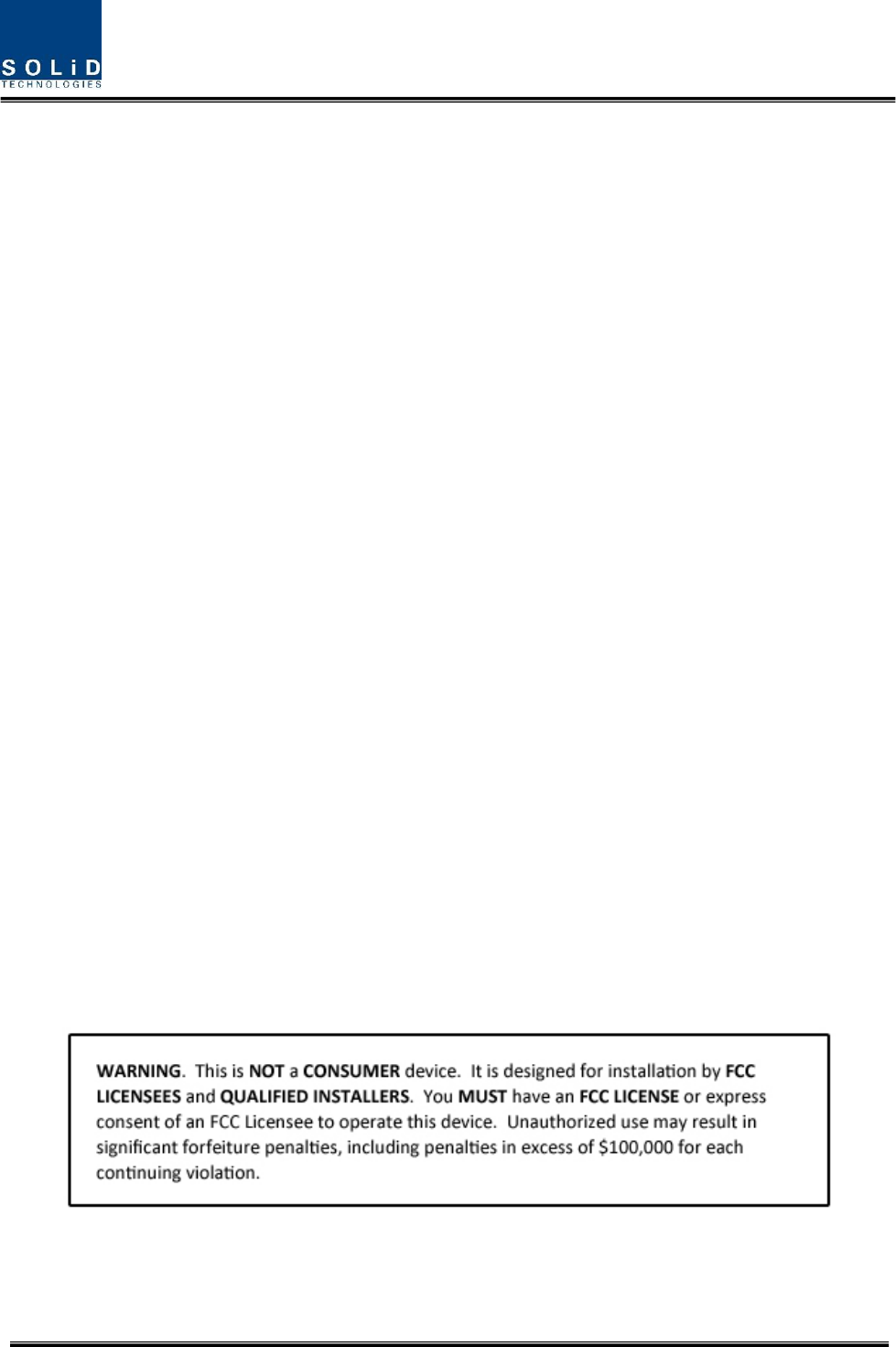
Confidential & Proprietary 7/27
- This power of this system shall be supplied through wiring installed in a normal building.
If powered directly from the mains distribution system, it shall be used additional protection,
such as overvoltage protection device
- Only 50 ohm rated antennas, cables and passive equipment shall be used with this remote.
Any equipment attached to this device not meeting this standard may cause degradation and
unwanted signals in the bi-directional system. All components connected to this device must
operate in the frequency range of this device.
- Only 50 ohm rated antennas, cables and passive components operating from 150 - 3 GHz
shall be used with this device.
- The following notice: "The Manufacturer's rated output power of this equipment is for single
carrier operation. For situations when multiple carrier signals are present, the rating would have
to be reduced by 3.5 dB, especially where the output signal is re-radiated and can cause
interference to adjacent band users. This power reduction is to be by means of input power or
gain reduction and not by an attenuator at the output of the device."
- The head end unit must always be connected to the Base Station using a direct cabled
connection. This system has not been approved for use with a wireless connection via
server antenna to the base station.
- Access can only be gained by SERVICE PERSONS or by USERS who have been instructed
about the reasons for the restrictions applied to the location and about any precautions that
shall be taken; and
- Access is through the use of a TOOL or lock and key, or other means of security, and is on
trolled by the authority responsible for the location.
- Signal booster warning label message should include

Confidential & Proprietary 8/27
- Use of unauthorized antennas, cables, and/or coupling devices not conforming with ERP/EIRP
and/or indoor-only restrictions is prohibited.
- Certification
FCC: This equipment complies with the applicable sections of Title 47 CFR Parts
15,22,24,27 and 90(Class B)
UL/CUL: This equipment complies with UL and CUL 1950-1 Standard for safety for
information technology equipment,including electrical business equipment
FDA/CDRH: This equipment uses a Class 1 LASER according to FDA/CDRH Rules.This
product conforms to all applicable standards of 21 CFR Chapter 1, Subchaper J, Part
1040

Confidential & Proprietary 9/27
Section2
System Overview
2.1 Purpose
2.2 SMDR-NH124

Confidential & Proprietary 10/27
2.1 Purpose
SMDR-NH124 is a coverage system for in-building services delivering voice and data in high
quality and for seamlessly.
As a distributed antenna system, it provides analog and digital phone systems that are served in
multiple bands through one antenna.
The system covers general public institutions and private facilities.
Shopping malls
Hotels
Campus areas
Airports
Clinics
Subways
Multi-use stadiums, convention centers, etc.
The system helps improve in-building radio environments in poor condition and make better
poor RSSI and Ec/Io. By providing communication services at every corner of buildings, the
system enables users to make a call at any site of buildings.
The system uses both analog (AMPS) and digital (TDMA, CDMA and WCDMA) methods.
The SMDR-NH124 system supports communication standards and public interface protocols in
worldwide use.
Frequencies: VHF,UHF, 700MHz, 800MHz,850MHz 900MHz,1900MHz,2100MHz, etc.
Voice protocols: AMPS,TDMA, CDMA,GSM,IDEN, etc.
Data protocols: EDGE,GPRS,WCDMA,CDMA2000,Paging, etc.
SMDR-NH124 is in modular structure per frequency. To provide desired frequency in a building,
all you need to do is to insert a corresponding frequency module into each unit. As it delivers
multiple signals with one optical cable, the system, in one-body type, does not require additional
facilities whenever new frequency is added.
The system is featured with the following:
Flexibiltiy & Scalabiltiy
Support fiber-optic ports up to 39
Clustering multiple-buildings (campus) as one coverage
Modular structures
Modular frequency upgrade
Plug-in type module
Multi-Band, Multi Operator

Confidential & Proprietary 11/27
Signals with a plurality of service provider transmit simultaneously
Support multi-operator in a band
Low OPEX / CAPEX
Compact design
Upgradable design
Easy installation and maintenance
Web Based SNMP or GSM Modem or UDP support (Optional)
2.2 SMDR-NH124
ROU receives TX optical signals from ODU or OEU and converts them into RF signals. The
converted RF signals are amplified through High Power Amp in a corresponding RDU,
combined with Multiplexer module and then radiated to the antenna port.
When receiving RX signals through the antenna port, this unit filters out-of-band signals in a
corresponding RDU and sends the results to Remote Optic Module to make electronic-optical
conversion of them. After converted, the signals are sent to a upper device of ODU or OEU.
ROU can be equipped with up to three RDUs (Remote Drive Unit) and the module is composed
of maximal Dual Band.
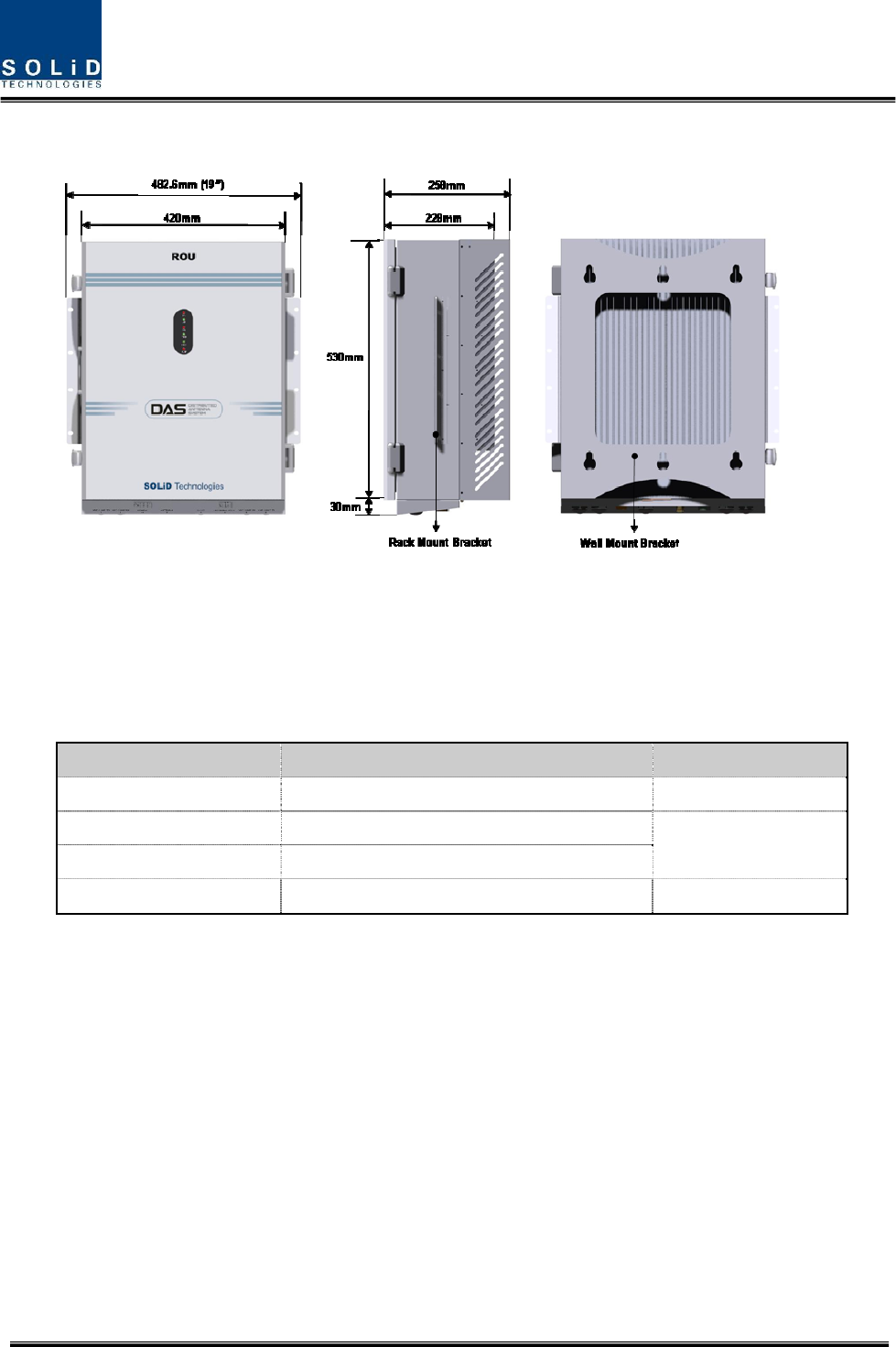
Confidential & Proprietary 12/27
2.3 Dimension
Figure 3.1 – ROU Outer Look
ROU is designed in a cabinet, and provides the following functions and features.
Item Spec. Remark
Size(mm) 482.6(19“) x 258 x560, Including Bracket
Weight 35.45 Kg Full Load
Power consumption 265 W
Operating Temperature ‐10to+50°C AmbientTempe rature

Confidential & Proprietary 13/27
Section3
System Installation
3.1 ROU Installation
3.1.1 ROU Enclosure installation
ROU is designed to be water- and dirt-proof. The unit has the structure of One-Body enclosure.
It satisfies water-proof and quake-proof standards equivalent of NEMA4.
ROU can be mounted into either of a 19” Standard Rack or on a Wall.
Basically, ROU has both of a Wall Mount Bracket and a Rack Mount Bracket.
Depending on the use of the Rack Mount Bracket, the bracket can be removed.
The following shows dimension of the fixing point for the Wall Mount Bracket.
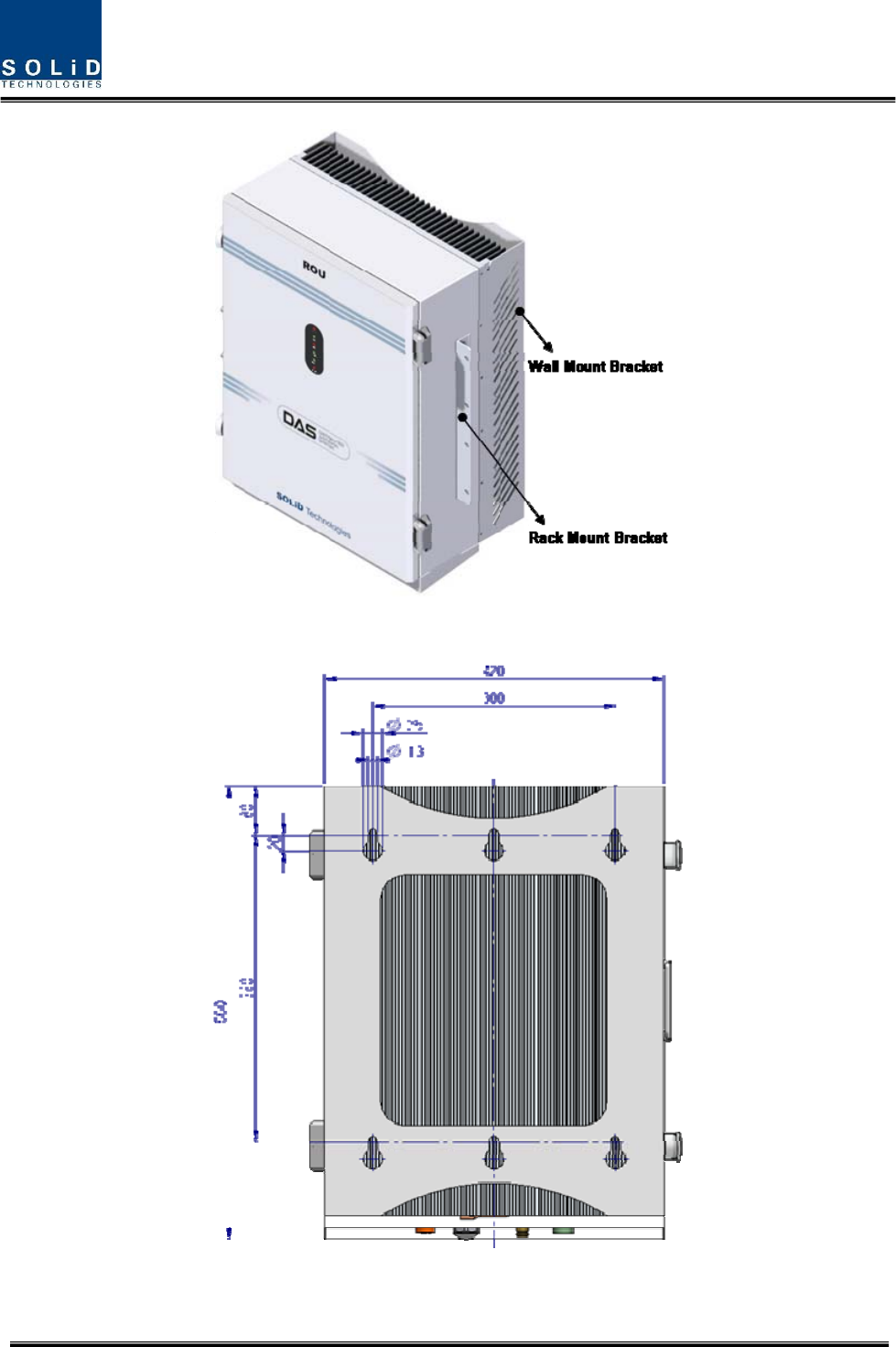
Confidential & Proprietary 14/27
Figure 3.2 – How to install ROU
Figure 3.3 – Dimension used to install ROU on the WALL
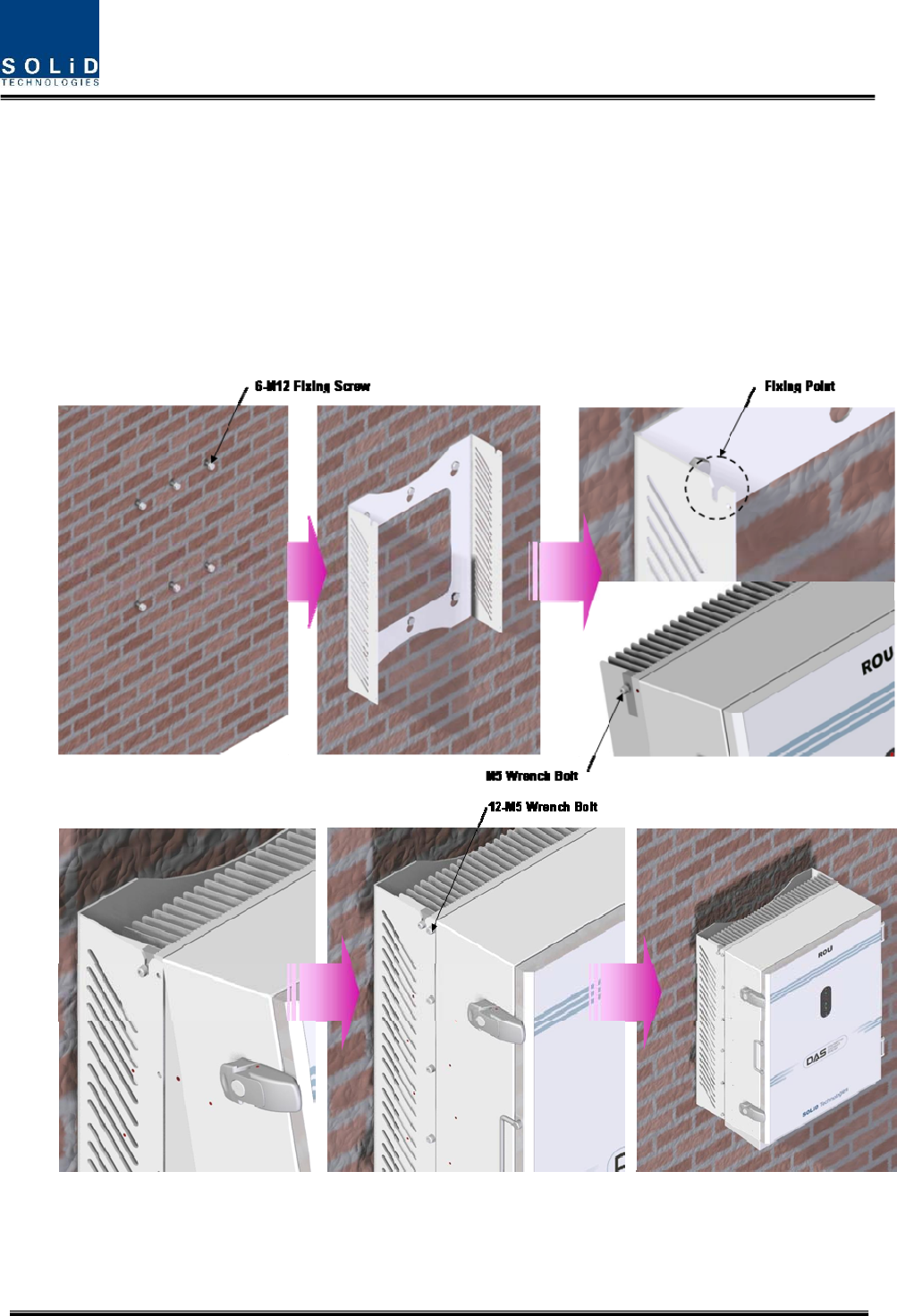
Confidential & Proprietary 15/27
ROU Wall Mount Installation
Turn M12 Fixing Screws by half on the wall and fully fix the screw with a Wall Mount Bracket on
it.
For convenience, the Wall Mount Bracket has fixing holes to let you easily mount an enclosure.
Turn the M5 Wrench Bolt by half at each side of the Heatsink of the enclosure.
Put the enclosure with the M5 Wrench Bolt fixed on the fixing groove and fix the M5 Wrench
Bolts into the remaining fixing holes.
In this case, you will use 12 M5 Wrench Bolts in total except bolts used for the fixing groove.
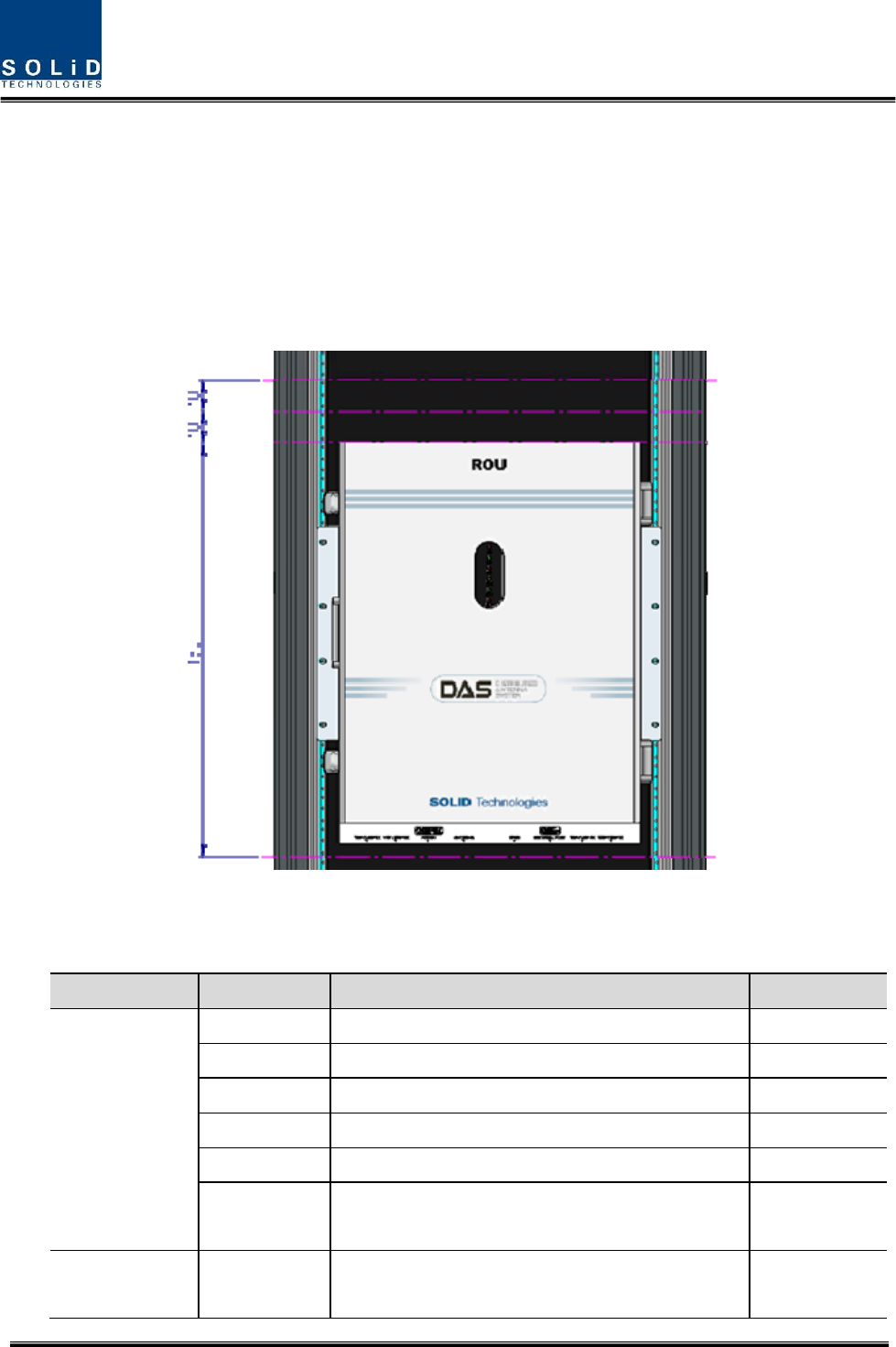
Confidential & Proprietary 16/27
ROU Rack Mount Installation
Like other units, ROU is designed to be inserted into a rack. The unit occupies around 13U of
space except cable connection.
ROU component
ROU has the following components:
No. Unit Description Remark
Common Part
Enclosure Including Rack & Wall cradle 1EA
RCPU - 1EA
R_OPTIC With SC/ACP adaptor 1EA
RPSU Alternative DC-48V or AC 120V 1EA
Multi-Plexer - 1EA
Power Cable - MS Connector with 3 hole to AC 120 plug(AC)
- MS Connector with 2 lug termination(DC)
Optional Part RDU+BPF 800PS,800PS+900I+Paging,850C,850C+700PS,
1900P+ AWS-1 RDU, VHF+UHF(NO BPF),
Up to 3EA to
be inserted
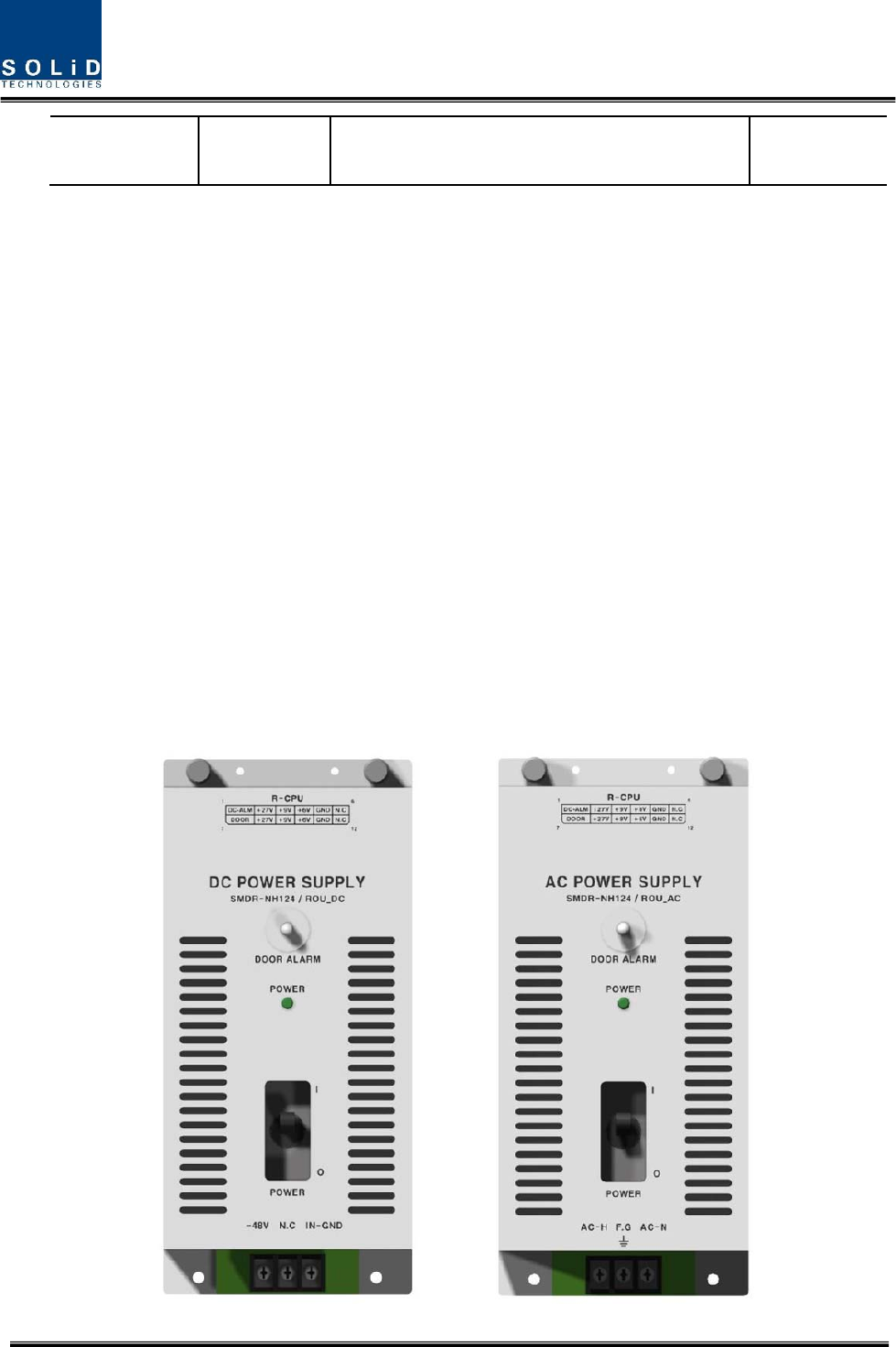
Confidential & Proprietary 17/27
850C+700LTEC, 700LTEF+850C
700LTEF SISO RDU, 700LTEF SISO RDU
Basically, the common part of ROU should have an enclosure and it is equipped with RCPU to
inquire and control state of each module, R_OPTIC to make both of electronic-optical and
optical-electronic conversions, RPSU to supply power for ROU and a Multi-Plexer to help share
multiple TX/RX signals through one antenna. It should have Power Cable for external rectifier or
to supply required power.
In addition, RDU can be inserted and removed to provide service for desired band (Optional).
3.1.2 ROU Power Cabling
ROU supports both of DC-48V and AC120V of input power. As RPSU for DC-48 and RPSU for
AC120V are separated from each other, you need to select one of them in case of purchase
order.
RPSU for DC -48V and RSPU for AC 120V have the same configuration and capacity while
each of the units uses different input voltage from each other.
The following figure shows configuration of RPSUs for DC -48V and AC 120V.
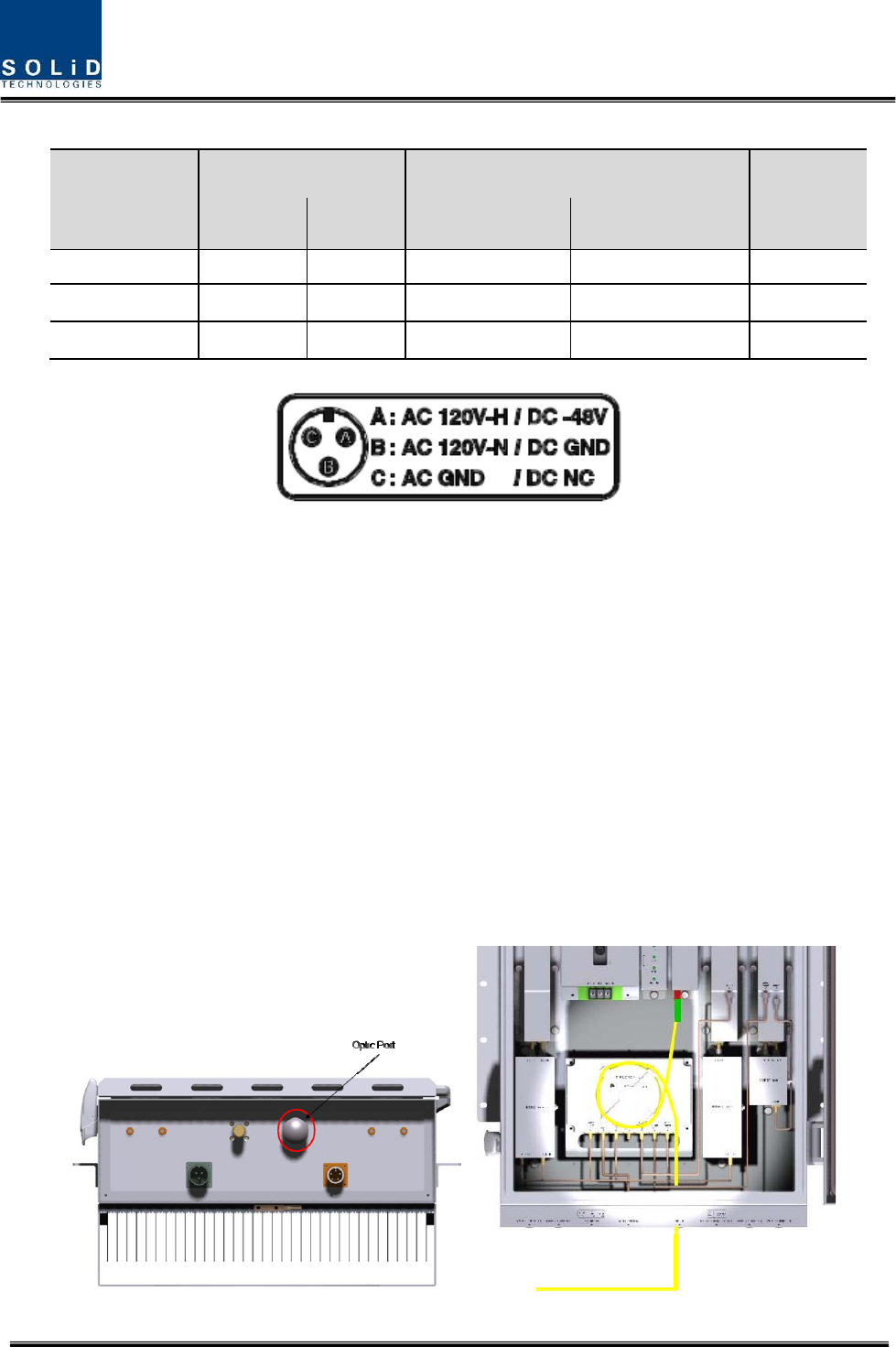
Confidential & Proprietary 18/27
MC Connector
numbering
Lug Naming RPSU Terminal naming
Remark
AC DC AC DC
A AC_H -48V AC-H -48V
B AC_N GND AC-N IN_GND
C GND DC NC FG FG
Check if the connection is the same as one seen in the table above and make sure to turn the
power ON.
3.1.3 Optical Cabling
ROU makes optical-electronic conversion of TX signals from upper ODU and OEU and makes
electronic- optical conversion of RX signals. ROU has one optical module in it. As WDM is
installed in the R_OPTIC module, two pieces of wavelength (TX:1310nm, RX:1550nm) can be
sent/received with one optical core at the same time. ROU has SC/APC of optical adaptor type.
For optical adaptor, SC/APC type can be used. To prevent the optical access part from being
marred with dirt, it should be covered with a cap during move. When devices are connected
through optical cables, you need to clear them using alcohocol to remove dirt.
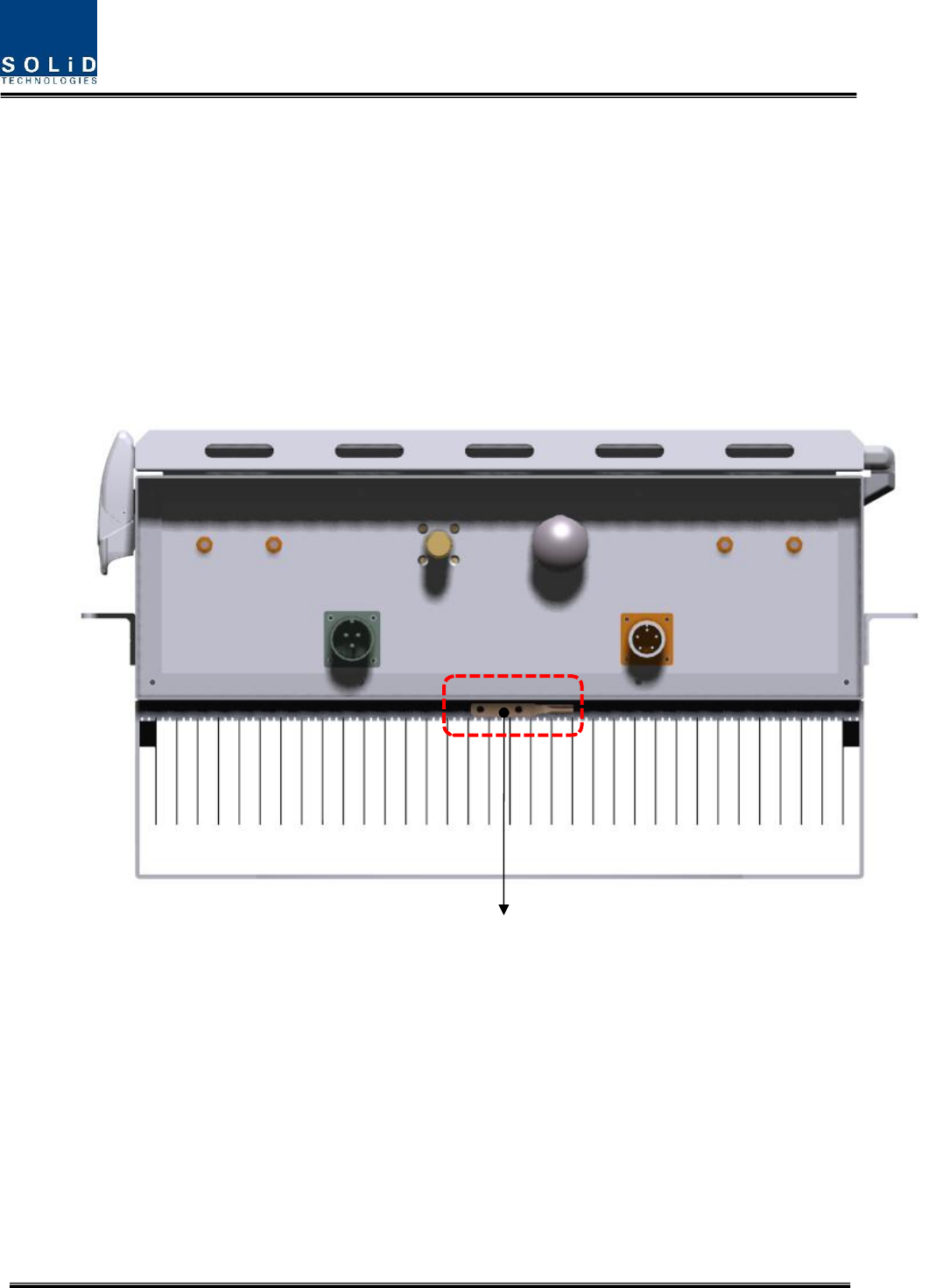
Confidential & Proprietary 19/27
Optical cables should be inserted into Optic Port outside of ROU. Using an optical slack devices
in ROU, you need to coil around one or two roll of cables to be connected with the optical
adaptor of ROPTIC.
At this time, curvature of the optical cable should be at least 10Ø to prevent insertion loss from
being increased.
Through GUI, check if PD value of ROPTIC is in a tolerable range (+4~-1dBm).
3.1.4 GND Terminal Connection
ROU has one GND terminal port where is on bottom side, like below
- Take off the GND terminal port from enclosure and connect to ground cable, then fix it
the position of enclosure again
- The opposite end of the ground cable should connect to the communication GND of
building
GND LUG

Confidential & Proprietary 20/27
3.1.5 Coaxial cable and Antenna Connection
- The coaxial cables which are connected to antenna distribued network connect to
antenna port of ROU. Before connection, check the VSWR value of coaxial cable
whether it is within specification using SITEMASTER .
- At this time, check if the Return loss have above 15Db or VSWR have below 1.5
- The part of antenna connection fasten to port not to be loosed and not to be injected
the dusty and insects
- The antenna connected to ROU is only serviced in inbuilding
3.1.6 Insertion of RDU
ROU has slots to enable up to three RDU modules to be inserted into the unit.
You can insert a RDU into any slot. It is not possible to provide services with a RDU
module alone; you need to connect the module with Cavity BPF in any case.
The table below shows types of RDU and CAVITY BPF:
No Unit naming Cavity BPF RF CABLE Multiplexer Interface
TX RX
1 RDU 800PS 800PS BPF TX CABLE 1EA
RX CABLE 1EA BPF OUT RDM RX IN
2 RDU 850C 850C BPF TX CABLE 1EA
RX CABLE 1EA
BPF TX
OUT BPF RX IN
3 RDU
1900P+AWS-1 1900P DUP TX/RX CABLE 1EA RDM AWS+1900P
4 RDU
800PS+900I+PA
800PS+900I+PA
BPF
TX CABLE 1EA
RX CABLE 1EA
RDM TX
OUT RDM RX IN
5 RDU
850C+700PS
850C+700PS
BPF
TX CABLE 1EA
RX CABLE 1EA
RDM TX
OUT RDM RX IN
6 RDU
850C+700PS(D)
850C+700PS
BPF
TX CABLE 1EA
RX CABLE 1EA
RDM TX
OUT RDM RX IN
7 RDU
VHF+UHF - TX CABLE 1EA
RX CABLE 1EA - -
8 RDU
E-VHF+UHF - TX CABLE 1EA
RX CABLE 1EA - -
9 RDU
850C+700LTEC
850C+700LTEC
BPF
TX CABLE 1EA
RX CABLE 1EA
RDM TX
OUT RDM RX IN

Confidential & Proprietary 21/27
10 RDU
700LTEF+850C
700LTEF+850C
BPF
TX CABLE 1EA
RX CABLE 1EA
RDM TX
OUT RDM RX IN
11 RDU
700LTEF SISO
700LTEF SISO
BPF
TX CABLE 1EA
RX CABLE 1EA
RDM TX
OUT RDM RX IN
12 RDU
700LTEF MIMO
700LTEF SISO
BPF
TX CABLE 2EA
RX CABLE 1EA
RDM TX
OUT RDM RX IN
13 1900P(MIMO)+
AWS-1(MIMO)
1900P DUP TX/RX CABLE 1EA RDM AWS+1900P
3.1.7 RDU Specifications Per band
Standard Unit naming Description Frequency range
TX(MHz) RX(MHz)
iDEN 700P Public safety 758 to 775 793 to 805
700PS(D) Public safety 763 to 775 788 to 805
iDEN 800P Public safety 851 to 869 806 to 824
Cellular 850C Cellular 869 to 894 824 to 849
Iden 900I SMR 929 to 940 896 to 902
Paging 900 PA Paging 929 to 930 896 to 902
PCS 1900P PCS 1930 to 1995 1850 to 1915
AWS-1 AWS-1 AWS-1 2110 to 2155 1710 to 1755
TDD LTE 2.5TDD TDD 2497.8~2687.4 2497.8~2687.4
- VHF Public safety 136 to 174 136 to 174
-
UHF
Public safety(Band1) 396 to 450
450 to 512
396 to 450
450 to 512
Public safety(Band2)
380 to 434
434 to 496
380 to 434
434 to 496
LTE 700LTE Long Term Evolution 728 to 757 699 to 716
777 to 787
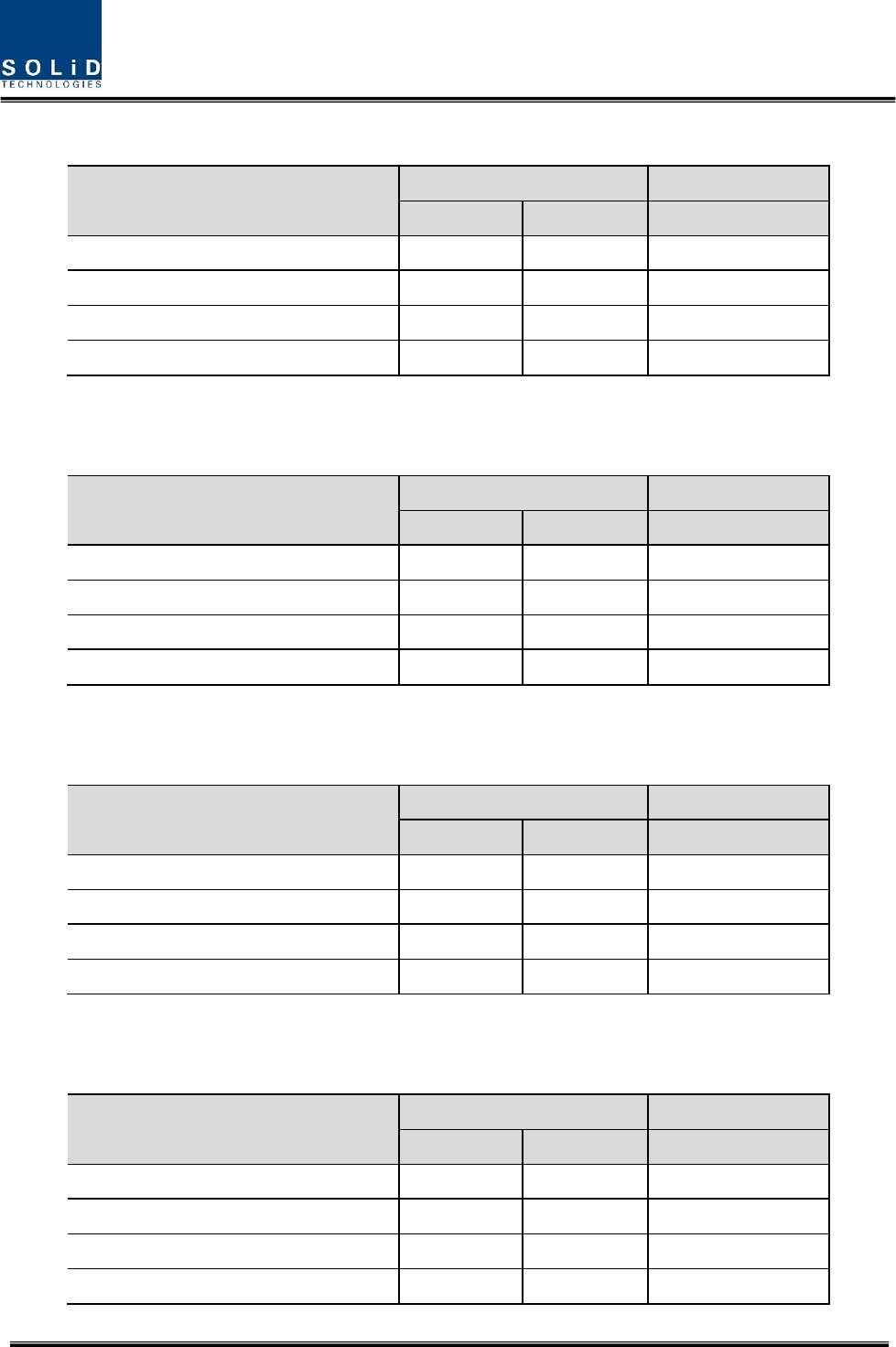
Confidential & Proprietary 22/27
700MHz Long Term Evolution
Parameters Typical Remarks
TX RX
Bandwidth 29MHz 28MHz
Output power +23dBm +0dBm Total
System Gain 43dB 50dB
input and output impedances 50ohm 50ohm
700MHz Long Term Evolution (MIMO)
Parameters Typical Remarks
TX RX
Bandwidth 29MHz 28MHz
Output power +25dBm +0dBm Total
System Gain 45dB 50dB
input and output impedances 50ohm 50ohm
700MHz Public safety
Parameters Typical Remarks
TX RX
Bandwidth 12MHz 12MHz
Output power +23dBm +0dBm Total
System Gain 43dB 50dB
input and output impedances 50ohm 50ohm
700MHz Public safety (D Block)
Parameters Typical Remarks
TX RX
Bandwidth 17MHz 17MHz
Output power +23dBm +0dBm Total
System Gain 43dB 50dB
input and output impedances 50ohm 50ohm
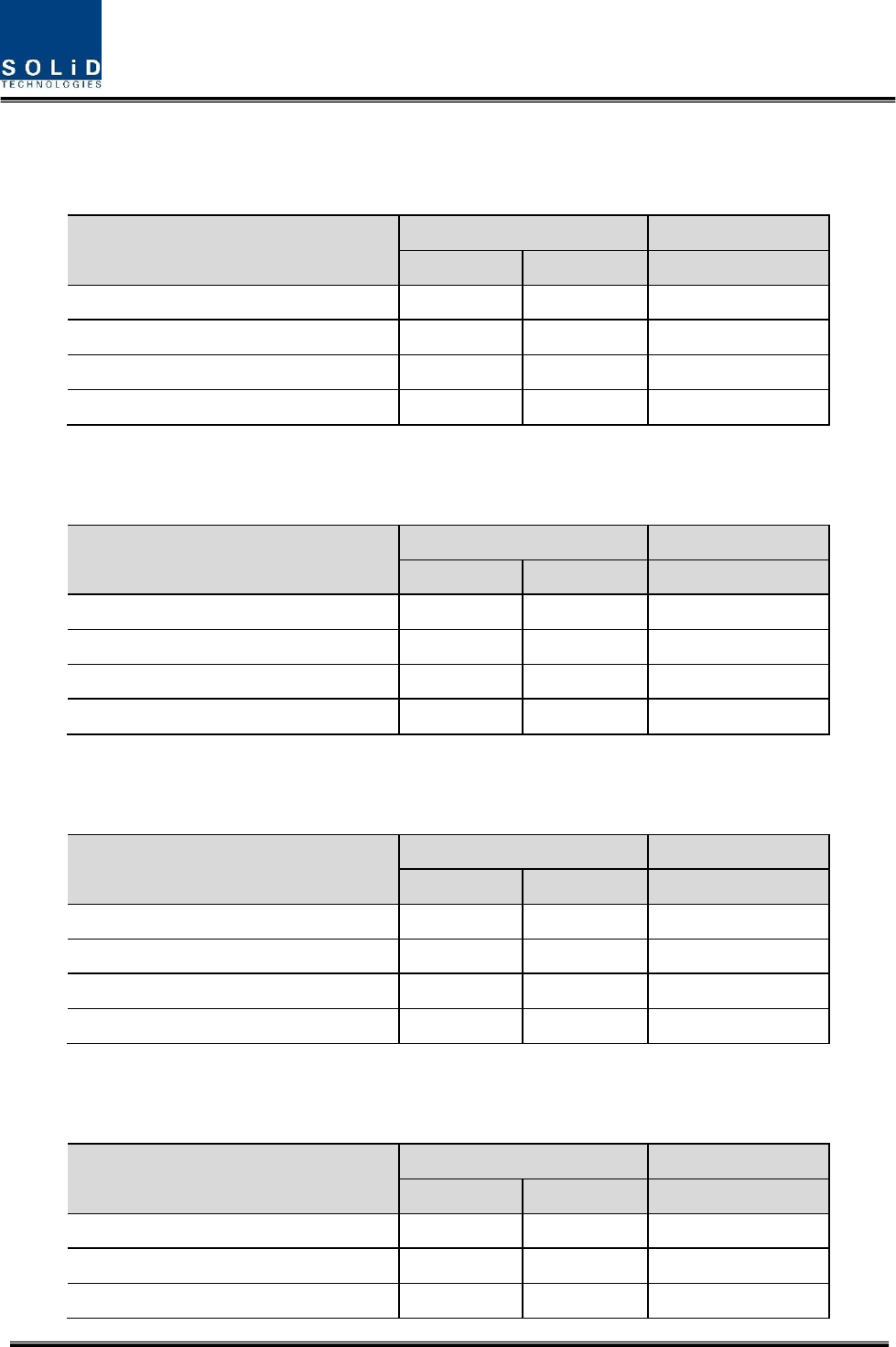
Confidential & Proprietary 23/27
800MHz Public safety
Parameters Typical Remarks
TX RX
Bandwidth 18MHz 18MHz
Output power +23dBm +0dBm Total
System Gain 43dB 50dB
input and output impedances 50ohm 50ohm
850MHz Cellular
Parameters Typical Remarks
TX RX
Bandwidth 25MHz 25MHz
Output power +23dBm +0dBm Total
System Gain 43dB 50dB
input and output impedances 50ohm 50ohm
900MHz iDEN & Paging
Parameters Typical Remarks
TX RX
Bandwidth 12MHz 6MHz
Output power +23dBm +0dBm Total
System Gain 43dB 50dB
input and output impedances 50ohm 50ohm
1900MHz PCS
Parameters Typical Remarks
TX RX
Bandwidth 65MHz 65MHz
Output power +26dBm +0dBm Total
System Gain 46dB 50dB
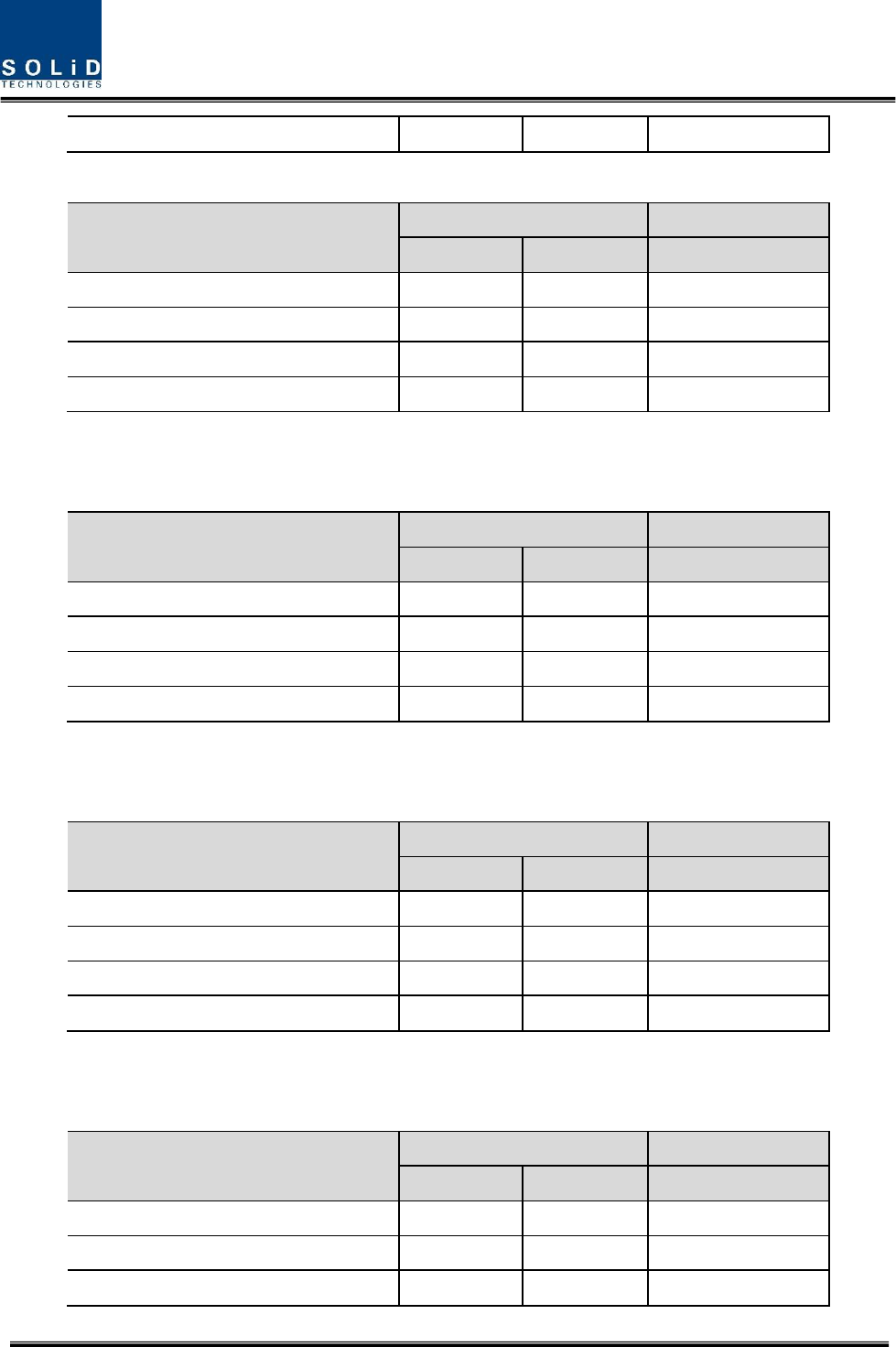
Confidential & Proprietary 24/27
input and output impedances 50ohm 50ohm
1900MHz PCS(MIMO)
Parameters Typical Remarks
TX RX
Bandwidth 65MHz 65MHz
Output power +30dBm +0dBm Total
System Gain 50dB 50dB
input and output impedances 50ohm 50ohm
1700MHz&2100MHz AWS-1
Parameters Typical Remarks
TX RX
Bandwidth 45MHz 45MHz
Output power +26dBm +0dBm Total
System Gain 46dB 50dB
input and output impedances 50ohm 50ohm
1700MHz&2100MHz AWS-1(MIMO)
Parameters Typical Remarks
TX RX
Bandwidth 45MHz 45MHz
Output power +30dBm +0dBm Total
System Gain 50dB 50dB
input and output impedances 50ohm 50ohm
150MHz VHF Public safety
Parameters Typical Remarks
TX RX
Bandwidth 38MHz 38MHz 136~174MHz
Output power +24dBm -4dBm Total
System Gain 39dB 50dB

Confidential & Proprietary 25/27
input and output impedances 50ohm 50ohm
450MHz UHF Public safety
Parameters Typical Remarks
TX RX
Bandwidth(Band1) 116MHz 116MHz
396~450MHz(54MHz)
450~512MHz(62MHz)
Band selection
Bandwidth(Band2) 116MHz 116MHz
380~434MHz(54MHz)
434~496MHz(62MHz)
Band selection
Output power +24dBm -4dBm Total
System Gain 39dB 50dB
input and output impedances 50ohm 50ohm
2.5TDD
Parameters Typical Remarks
TX RX
Bandwidth 189.6MHz 189.6MHz
Output power +30dBm -20dBm Total
System Gain 50dB 30dB
input and output impedances 50ohm 50ohm

Confidential & Proprietary 26/27
RSS-GEN, Sec. 7.1.2 – (transmitters)
Under Industry Canada regulations, this radio transmitter may only operate using an antenna of
a type and maximum (or lesser) gain approved for the transmitter by Industry Canada. To
reduce potential radio interference to other users, the antenna type and its gain should be so
chosen that the equivalent isotropically radiated power (e.i.r.p.) is not more than that necessary
for successful communication.
Conformément à la réglementation d’Industrie Canada, le présent émetteur radio peut
fonctionneravec une antenne d’un type et d’un gain maximal (ou inférieur) approuvé pour
l’émetteur par Industrie Canada. Dans le but de réduire les risques de brouillage radioélectrique
à l’intention desautres utilisateurs, il faut choisir le type d’antenne et son gain de sorte que la
puissance isotroperayonnée quivalente (p.i.r.e.) ne dépassepas l’intensité nécessaire à
l’établissement d’une communication satisfaisante.
RSS-GEN, Sec. 7.1.2 – (detachable antennas)
This radio transmitter (identify the device by certification number, or model number if Category
II)has been approved by Industry Canada to operate with the antenna types listed below with
the maximum permissible gain and required antenna impedance for each antenna type
indicated. Antenna types not included in this list, having a gain greater than the maximum gain
indicated for that type, are strictly prohibited for use with this device.
Le présent émetteur radio (identifier le dispositif par son numéro de certification ou son numéro
de modèle s’il fait partie du matériel de catégorie I) a été approuvé par Industrie Canada pour
fonctionner avec les types d’antenne énumérés ci-dessous et ayant un gain admissible maximal
et l’impédance requise pour chaque type d’antenne. Les types d’antenne non inclus dans cette
liste,ou dont le gain est supérieur au gain maximal indiqué, sont strictement interdits pour
l’exploitation de l’émetteur.
RF Radiation Exposure
This equipment complies with RF radiation exposure limits set forth for an uncontrolled
environment. This equipment should be installed and operated with a minimum distance of 200
cm between the radiator and your body. This transmitter must not be co-located or operating in
conjunction with any other antenna or transmitter. RF exposure will be addressed at time of
installation and the use of higher gain antennas may require larger separation distances.

Confidential & Proprietary 27/27
RSS-102 RF Exposure
L’antenne (ou les antennes) doit être installée de façon à maintenir à tout instant une distance
minimum de au moins 200 cm entre la source de radiation (l’antenne) et toute personne
physique. Cet appareil ne doit pas être installé ou utilisé en conjonction avec une autre antenne
ou émetteur.
Warning Statement
Antennas must be installed in accordance with FCC 27.50 and SRSP-517. The height of the
antenna above average terrain (HAAT) is permitted over 1372m. For different gain antennas
refer to the relevant rules.